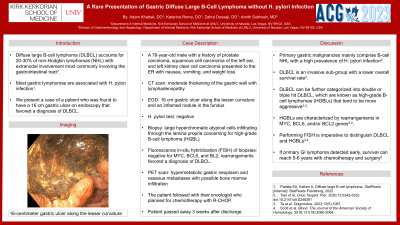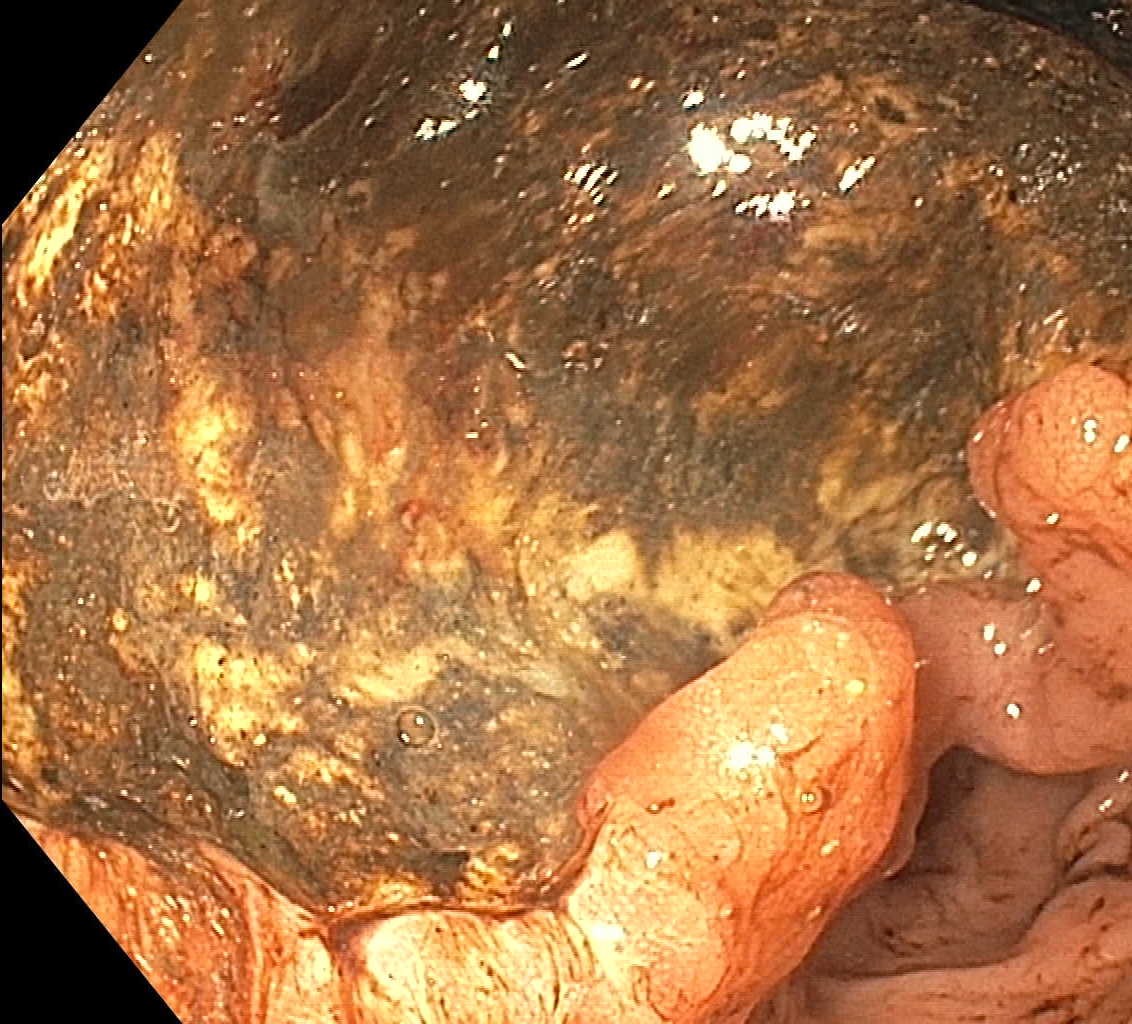Sunday Poster Session
Category: Stomach
P1379 - A Rare Presentation of Gastric Diffuse Large B-Cell Lymphoma Without H. pylori Infection
Sunday, October 22, 2023
3:30 PM - 7:00 PM PT
Location: Exhibit Hall

Has Audio
.jpg)
Adam M. Khattak, DO
Kirk Kerkorian School of Medicine at UNLV
Las Vegas, NV
Presenting Author(s)
Adam Khattak, DO, Katerina Roma, DO, Zahra Dossaji, DO, Amith Subhash, MD
Kirk Kerkorian School of Medicine at UNLV, Las Vegas, NV
Introduction: Diffuse large B-cell lymphoma (DLBCL) accounts for 20-30% of non-Hodgkin lymphomas (NHL) with extranodal involvement most commonly involving the gastrointestinal tract (1). Most gastric lymphomas are associated with H. pylori infection (1). We present a case of a patient who was found to have a 16 cm gastric ulcer on endoscopy that favored a diagnosis of DLBCL.
Case Description/Methods: A 78-year-old male with a history of prostate carcinoma status post radiation, squamous cell carcinoma of the left ear status post resection, and left kidney clear cell carcinoma status post partial nephrectomy presented to the emergency room with nausea, vomiting, and weight loss. A CT scan revealed moderate thickening of the gastric wall with lymphadenopathy. An esophagogastroduodenoscopy with biopsy revealed a 16 cm gastric ulcer along the lesser curvature, and an inflamed nodule in the fundus. H. pylori testing returned negative. Ulcer biopsy revealed large hyperchromatic atypical cells infiltrating through the lamina propria concerning for high-grade B-cell lymphoma (HGBL). However, fluorescence in-situ hybridization (FISH) of the biopsies was negative for MYC, BCL6, and BL2 rearrangements favoring a diagnosis of DLCBL. A PET scan revealed hypermetabolic gastric neoplasm and osseous metastases with possible bone marrow infiltration. The patient discharged and followed with their oncologist who planned for chemotherapy with Rituximab, cyclophosphamide, doxorubicin, vincristine, and prednisone (R-CHOP). Unfortunately, the patient passed away 3 weeks after discharge.
Discussion: Primary gastric malignancies mainly comprise B-cell NHL with a high prevalence of H. pylori infection (2). DLBCL is an invasive sub-group with a lower overall survival rate (2). DLBCL can be further categorized into double or triple hit DLBCL using FISH, which are known as high-grade B-cell lymphomas (HGBLs) that tend to be more aggressive (3,4). 1-12% of HGBLs have DLBCL morphology (4). HGBLs are characterized by rearrangements in MYC, BCL6, and/or BCL2 genes (3,4). Performing FISH is imperative to distinguish DLBCL and HGBLs due to their distinct prognostic factors and treatment response (3,4).
When PGIL is detected early, overall survival can reach up to 5-6 years with chemotherapy and surgery (2). Unfortunately, our patient was diagnosed with advanced DLBCL upon presentation. This case highlights the diversity of GI NHL and DLCBL while emphasizing the importance of early detection and treatment of H. pylori and primary GI NHL.

Disclosures:
Adam Khattak, DO, Katerina Roma, DO, Zahra Dossaji, DO, Amith Subhash, MD. P1379 - A Rare Presentation of Gastric Diffuse Large B-Cell Lymphoma Without H. pylori Infection, ACG 2023 Annual Scientific Meeting Abstracts. Vancouver, BC, Canada: American College of Gastroenterology.
Kirk Kerkorian School of Medicine at UNLV, Las Vegas, NV
Introduction: Diffuse large B-cell lymphoma (DLBCL) accounts for 20-30% of non-Hodgkin lymphomas (NHL) with extranodal involvement most commonly involving the gastrointestinal tract (1). Most gastric lymphomas are associated with H. pylori infection (1). We present a case of a patient who was found to have a 16 cm gastric ulcer on endoscopy that favored a diagnosis of DLBCL.
Case Description/Methods: A 78-year-old male with a history of prostate carcinoma status post radiation, squamous cell carcinoma of the left ear status post resection, and left kidney clear cell carcinoma status post partial nephrectomy presented to the emergency room with nausea, vomiting, and weight loss. A CT scan revealed moderate thickening of the gastric wall with lymphadenopathy. An esophagogastroduodenoscopy with biopsy revealed a 16 cm gastric ulcer along the lesser curvature, and an inflamed nodule in the fundus. H. pylori testing returned negative. Ulcer biopsy revealed large hyperchromatic atypical cells infiltrating through the lamina propria concerning for high-grade B-cell lymphoma (HGBL). However, fluorescence in-situ hybridization (FISH) of the biopsies was negative for MYC, BCL6, and BL2 rearrangements favoring a diagnosis of DLCBL. A PET scan revealed hypermetabolic gastric neoplasm and osseous metastases with possible bone marrow infiltration. The patient discharged and followed with their oncologist who planned for chemotherapy with Rituximab, cyclophosphamide, doxorubicin, vincristine, and prednisone (R-CHOP). Unfortunately, the patient passed away 3 weeks after discharge.
Discussion: Primary gastric malignancies mainly comprise B-cell NHL with a high prevalence of H. pylori infection (2). DLBCL is an invasive sub-group with a lower overall survival rate (2). DLBCL can be further categorized into double or triple hit DLBCL using FISH, which are known as high-grade B-cell lymphomas (HGBLs) that tend to be more aggressive (3,4). 1-12% of HGBLs have DLBCL morphology (4). HGBLs are characterized by rearrangements in MYC, BCL6, and/or BCL2 genes (3,4). Performing FISH is imperative to distinguish DLBCL and HGBLs due to their distinct prognostic factors and treatment response (3,4).
When PGIL is detected early, overall survival can reach up to 5-6 years with chemotherapy and surgery (2). Unfortunately, our patient was diagnosed with advanced DLBCL upon presentation. This case highlights the diversity of GI NHL and DLCBL while emphasizing the importance of early detection and treatment of H. pylori and primary GI NHL.

Figure: 16 cm gastric ulcer along the lesser curvature
Disclosures:
Adam Khattak indicated no relevant financial relationships.
Katerina Roma indicated no relevant financial relationships.
Zahra Dossaji indicated no relevant financial relationships.
Amith Subhash indicated no relevant financial relationships.
Adam Khattak, DO, Katerina Roma, DO, Zahra Dossaji, DO, Amith Subhash, MD. P1379 - A Rare Presentation of Gastric Diffuse Large B-Cell Lymphoma Without H. pylori Infection, ACG 2023 Annual Scientific Meeting Abstracts. Vancouver, BC, Canada: American College of Gastroenterology.
